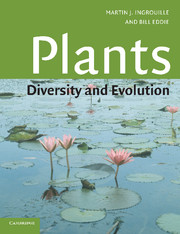Book contents
Chapter 5 - Ordering the paths of diversity
Published online by Cambridge University Press: 05 June 2012
Summary
They are all bound, each to each by powers that are virtues; the path of each is traced and each one finds its own path.
André Gide, 1897The phylogeny of plants
One of the best ways to understand variation is by comparison among related groups. Perhaps the greatest early success in this approach was that of Hoffmeister in the nineteenth century when he realised that the evolution of ovules and seeds could be best understood by understanding the variations of heterosporous and endosporic nonseed plants. The availability of an independently-derived phylogeny, from DNA sequence data, has vastly increased the power of this comparative approach.
Looking at phylogeny it is clear that particular forms have evolved repeatedly. Time and again similar morphologies and anatomies have evolved separately in distinct lineages. These examples provide a key to understanding the evolution of plants not just in terms of adaptation, say in understanding a convergent feature as one that has evolved to fit a similar function, but perhaps more importantly in understanding the shared environmental and developmental processes that have constrained or permitted certain evolutionary pathways.
The paths of diversity
Imagine the map of diversity as if it were a city plan. There are the city blocks, at different longitudes and latitudes of morphology, anatomy, physiology and chemistry. These are the archetypes. They are connected by the paths that represent the developmental pathways between them.
- Type
- Chapter
- Information
- PlantsDiversity and Evolution, pp. 191 - 251Publisher: Cambridge University PressPrint publication year: 2006



